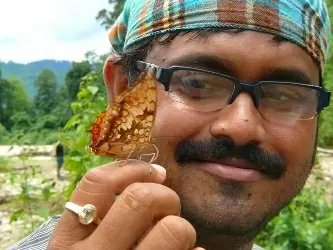Feel the pulse of the ecosystem from the flutter of butterflies

04-November-2010
Vol 1 | Issue 10
The presence of butterflies indicates a healthy ecosystem and to ensure that his City of Joy bathes in a rainbow of flutter, Arjan Basu Roy, the secretary of Nature Mates, a Kolkata based organization working to sensitize people about nature, and the West Bengal Forest Department (WBFD) have developed Banabitan Butterfly Garden in Salt Lake.
Roy has also been associated with other butterfly garden projects to conserve butterflies in eastern India at Suntalekhola, Chilapata Eco-tourism zone and Tiya Bon, all initiatives by the Directorate of Forest, government of West Bengal.
 |
|
Butterflies are not merely beautiful fluttering creatures, but are the most prominent bio-diversity indicators, according to Arjan Basu Roy
|
“Butterflies are the most prominent bio-diversity indicators,” points out Roy. “Through them you can understand whether the bio-diversity of a region is secure or not.
"Where there are butterflies the ecosystem is secure and human beings who comprise the largest component of the ecosystem are not under threat. If butterflies dwindle, mankind will be the worst hit,” he adds.
Luckily, Kolkata is still a rich haven for butterflies with an impressive 120 to 150 species. As a result of Roy’s passion Banabitan Butterfly Garden in Salt Lake’s central park is a pretty colourful maze of butterflies happily frolicking sweet scented nectar plants like lantana, periwinkle, cosmos and hibiscus.
Butterflies need larval food plants on which they lay their eggs and caterpillars feed and nectar plants for the butterflies to feed. With species like blue tiger, plain barred owl and more common species like plain and glassy tigers, common yellow and common five rings already visiting, providing them a habitat rich in nectar and host plants make it possible for them to multiply.
Roy’s initiative to conserve butterflies is also working as a catalyst to conserve some of the predators like birds and lizards who feed on butterflies. “We have noticed a steady increase in the mynah, jungle babbler and black drongo,” says Roy, who inherited his appreciation for wildlife from his father Ajoy Basu Roy.
To sustain his family Roy was forced to put his passion on hold and start a printing business. A qualified engineer with three diplomas in engineering including one from the renowned Regional Institute of Printing Technology (RIPT), Roy had no idea then that he was destined for greater things.
Interestingly, Roy’s induction into conservation came accidentally in 2004 when he took an order to print brochures for the WBFD. He came into contact with officials in the forest department who shared a thirst for conserving nature and in July 2005 Roy was included in a project by West Bengal Forest Development Corporation Ltd. to develop Gar Panchakot in Purulia as a destination for traditional herbal treatment.
Though he started out as a wildlife photographer Roy found himself restrained as he could not afford a big lenses camera, imperative for wildlife photography. But, on first May 2005 Roy got an idea.
“I was standing in Garpanchkot in Purulia when a beautiful butterfly of the Diana species caught my fancy. The micro-lenses required to photograph butterflies was within my capacity.” And then, as he puts it, “I decided to photograph butterflies and ultimately began conserving them.”














